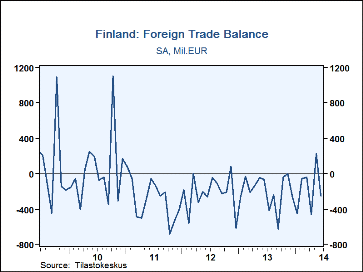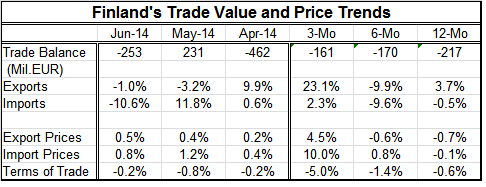 Global| Aug 15 2014
Global| Aug 15 2014Finland's Trade Balance Turns Negative Again
Summary
With Russian sanctions biting, we saw the first impact on European growth in the recent GDP figures. Germany is now the largest trading partner with Russia in the European Monetary Union, having just surpassed Finland. However, [...]
 With Russian sanctions biting, we saw the first impact on European growth in the recent GDP figures. Germany is now the largest trading partner with Russia in the European Monetary Union, having just surpassed Finland. However, Finland continues to have strong trade relations with Russia and we are monitoring the economic impact.
With Russian sanctions biting, we saw the first impact on European growth in the recent GDP figures. Germany is now the largest trading partner with Russia in the European Monetary Union, having just surpassed Finland. However, Finland continues to have strong trade relations with Russia and we are monitoring the economic impact.
The chart above shows Finland's foreign trade balance. The trade account has been in persistent deficit since 2011. In late 2013 and early 2014, there is some sign of the deficit being diminished. Last month there was a brief surplus. But now conditions have turned back to deficit.
Finland's exports fell for two consecutive months; they fell by 1% in June and by 3.2% in May. However, the three-month growth rate is a superheated 23% at an annual rate due to a 9.9% surge of exports in April.
Finland's imports have been jagged. They fell by 10.6% in June after an 11.8% rise in May. The three-month growth rate of 2.3% is quite moderate but much stronger than either its six-month or 12-month rate of growth. The Finnish economy has been struggling.
The surge in exports over three months at 23% annual rate compared to a 4.5% annual rate increase in prices, so most of that surge was trade volume. But imports, which rose by 2.3% over three months, saw import prices climb by 10%, marking the import gain as one in value only as a volume of imports fell at about 8% annual rate.
Finland is facing deterioration in its terms of trade. Terms of trade are simply the ratio of export prices to import prices. Economists use this measure as shorthand for the value of exporting versus importing. In Finland's case, we can see that it's paying increasingly more for its exports and getting less for its imports and that creates a drag on an economy.
There is no clear indicator in aggregate trade data that Finland is being dragged down by the sanctions with Russia. However its surge of exports in April may have occurred to try to get in ahead in the case that European sanctions would be on their way. The European sanctions are mostly new; sanctions imposed by the U.S. preceded them. Many Europeans thought that they would be able to avoid imposing sanctions on Russia. But the shooting down of the Malaysian airliner was a tipping point that brought the Europeans into the program of imposing more damaging sanctions. The sanctions on Russia are having an impact. Russian oil firm Rosneft is asking Russia for a $42 billion loan. It is feeling the impact of economic sanctions. But clearly there will be a blowback to Europe as well. We expect Germany and Finland to be the two EMU economies that will be most affected.

Robert Brusca
AuthorMore in Author Profile »Robert A. Brusca is Chief Economist of Fact and Opinion Economics, a consulting firm he founded in Manhattan. He has been an economist on Wall Street for over 25 years. He has visited central banking and large institutional clients in over 30 countries in his career as an economist. Mr. Brusca was a Divisional Research Chief at the Federal Reserve Bank of NY (Chief of the International Financial markets Division), a Fed Watcher at Irving Trust and Chief Economist at Nikko Securities International. He is widely quoted and appears in various media. Mr. Brusca holds an MA and Ph.D. in economics from Michigan State University and a BA in Economics from the University of Michigan. His research pursues his strong interests in non aligned policy economics as well as international economics. FAO Economics’ research targets investors to assist them in making better investment decisions in stocks, bonds and in a variety of international assets. The company does not manage money and has no conflicts in giving economic advice.






